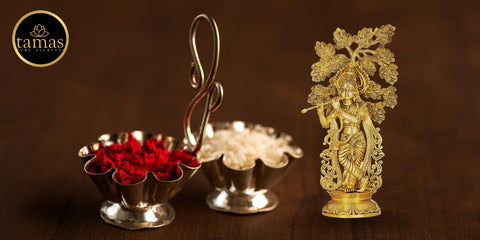
India is a country that is steeped in history and tradition. One of the most important aspects of Indian culture is its rich and diverse religious heritage, which is reflected in the countless number of gods and goddesses that are worshipped throughout the country. Brass idols are an integral part of this religious heritage, and they have been used for centuries to represent various deities in Hinduism, Buddhism, Jainism, and other religions.
Brass is a metal alloy that is made by combining copper and zinc in different proportions. It has been used in India for thousands of years to make a variety of objects, including utensils, lamps, and idols. The tradition of making brass idols dates back to ancient times, when metalworking was considered a sacred art form. The earliest known brass idols were created during the Indus Valley Civilization, which existed in the Indian subcontinent between 2600 BCE and 1900 BCE.
The production of brass idols reached its peak during the medieval period, when India was ruled by powerful dynasties such as the Cholas, the Pallavas, and the Vijayanagar Empire. During this time, brass idols were not only used for religious purposes but also as a form of political propaganda. Kings and queens would commission grandiose statues of themselves and their families to showcase their wealth and power.
The significance of brass idols in Indian culture lies in their ability to represent the divine. Hindus believe in a pantheon of gods and goddesses, each of whom represents a different aspect of the universe. Brass idols are used to represent these deities, and they are worshipped as living manifestations of the divine. In many Hindu households, brass idols of various gods and goddesses are kept in a special place of honor, and offerings of food, flowers, and incense are made to them on a daily basis.
Brass idols are also an important part of religious festivals and ceremonies in India. During the annual festival of Ganesh Chaturthi, for example, large brass idols of the elephant-headed god Ganesh are paraded through the streets and worshipped by millions of devotees. Similarly, during the festival of Durga Puja, elaborate brass idols of the goddess Durga are created and worshipped for nine days.
Aside from their religious significance, brass idols also have cultural and artistic value. Brass idol-making is considered a traditional art form in India, and many families have been involved in the craft for generations. The process of making a brass idol involves several steps, including casting, filing, polishing, and painting. Skilled artisans can create intricate designs and details using simple tools and techniques.
Conclusion
There has been growing concern about the environmental impact of brass idol-making. The process of casting brass involves the use of harmful chemicals and metals, which can have a detrimental effect on the environment and on the health of the artisans who work with them. As a result, there has been a movement towards using more eco-friendly materials and techniques in the production of brass idols.
Despite these challenges, brass idols remain an important part of Indian culture and heritage. They represent the rich and diverse religious traditions of the country, as well as the artistic and cultural achievements of its people. Whether used for religious worship or as decorative objects, brass idols continue to be cherished and admired by millions of people around the world.
In conclusion, brass idols hold a significant place in Indian culture and have played an important role in the country's history and tradition. They represent the divine and the artistic, and are valued for their religious, cultural, and artistic significance. While the process of making brass idols may have evolved over time, their beauty and significance remain unchanged, and they continue to inspire awe and reverence among All people Of the world.





